Boeing 247
| Boeing 247 | |
|---|---|
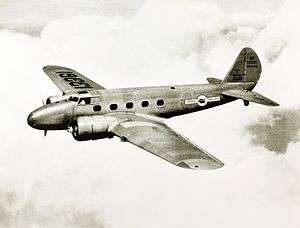 | |
| United Air Lines Boeing 247D in flight | |
| Role | Passenger airliner |
| Manufacturer | Boeing |
| First flight | February 8, 1933 |
| Introduction | May 22, 1933[1] |
| Status | Retired |
| Primary user | Boeing Air Transport |
| Number built | 75 |
|
| |
The Boeing Model 247 was an early United States airliner, considered the first such aircraft to fully incorporate advances such as all-metal (anodized aluminium) semimonocoque construction, a fully cantilevered wing and retractable landing gear.[2][3] Other advanced features included control surface trim tabs, an autopilot and de-icing boots for the wings and tailplane.[4]
"Ordered off the drawing board", the 247 first flew on February 8, 1933 and entered service later that year.[5] Subsequently, development in airliner design saw engines and airframes becoming larger and four-engined designs emerged, but no significant changes to this basic formula appeared until cabin pressurization and high altitude cruise were introduced in 1940, with the first pressurized airliner, the Boeing 307 Stratoliner.[5]
Design and development
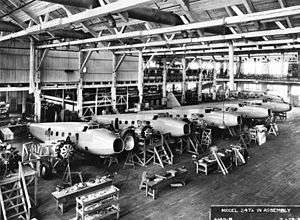
Boeing had eclipsed other aviation manufacturers by introducing a host of aerodynamic and technical features into a commercial airliner. This advanced design, which was a progression from earlier Monomail (Models 200, 221, 221A) and B-9 bomber designs, combined speed and safety. The Boeing 247 was faster than the U.S. premier fighter aircraft of its day, the Boeing P-12, which was an open-cockpit biplane.[6] Yet its flight envelope included a rather docile 62 mph (100 km/h) landing speed, which precluded the need for flaps, and pilots learned that at speeds as low as 10 mph (15 km/h), the 247 could be taxied "tail high" for ease of ground handling.[7]
The 247 was the first twin-engined passenger transport able to fly on one engine. With controllable pitch propellers (standard equipment on the 247D), the 247 could maintain 11,500 feet (3,500 m) at maximum gross takeoff weight.[8] Its combination of features set the standard for the Douglas DC-1 and other airliners before World War II.[5] Originally planned as a 14-passenger airliner powered by Pratt & Whitney R-1690 Hornet radial engines, the preliminary review of the design concept by United Air Lines' pilots had resulted in a redesign to a smaller, less capable design configuration, powered by R-1340 wasp engines.[9][10][11]
One concern of the pilots was that no airfield then in existence, in their view, could safely take an eight-ton aircraft.[10] They also objected to the use of Hornet engines, because most pilots were accustomed to the less-powerful Wasps and would find Hornets overpowering. Pratt & Whitney's chief engineer, George Mead, knew that this thinking was misguided and that within a few years it would seem antiquated.[10] P&W's president, Frederick Rentschler, faced with a tough decision, decided to acquiesce to the airline pilots' unanimous demand. The decision created a rift between Mead and Rentschler.[10] Despite the bitter disagreements on design and engines, the 247 was still a remarkable achievement and was Boeing's showcase exhibit at the 1933 Chicago World's Fair.[12]
The cockpit windshield of the first 247s was angled forward, instead of the conventional aft sweep. This was the design solution (similar to that adopted by other contemporary aircraft that used a forward-raked windscreen) to the problem of lighted control panel instruments reflecting off the windshield at night, but it turned out that the forward-sloping windshield would reflect ground lights instead, especially during landings and it also increased drag slightly.[13][14] By the introduction of the 247D, the windshield was sloped aft in the usual way, and the night-glare problem was resolved by installing an extension (the glarescreen) over the control panel.[15]
Boeing considered safety features highly, building in structural strength as well as incorporating design elements that enhanced customer comfort and well-being, such as the thermostatically-controlled, air conditioned and soundproof cabin. The crew included a pilot and copilot as well as a flight attendant who could tend to passenger needs.[16] The main landing gear did not fully retract; a portion of the wheels extended below the nacelles, typical of designs of the time, as a means of reducing structural damage in a wheels-up landing. The tailwheel was not retractable. While the Model 247 and 247A had speed-ring engine cowlings and fixed-pitch propellers, the Model 247D incorporated NACA cowlings and variable-pitch propellers.[17]
Operational history
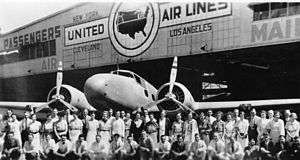
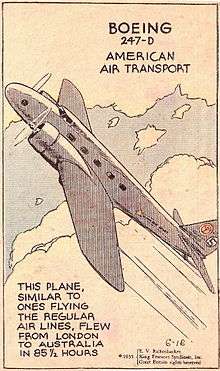

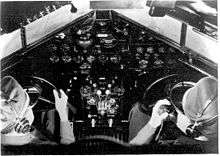
As the 247 emerged from its test and development phase, the company further showcased its capabilities by entering a long-distance air race in 1934, the MacRobertson Air Race from England to Australia. During the 1930s, aircraft designs were often proven in air races and other aerial contests. A modified 247D was entered, flown by Colonel Roscoe Turner and Clyde Pangborn.[18] The 247, race number "57," was essentially a production model but all airliner furnishings were removed to accommodate eight additional fuselage fuel tanks.[19] The MacRobertson Air Race attracted aircraft entries from all over the globe, including prototypes as well as established production types, with the gruelling course considered an excellent proving ground as well as an opportunity to gain worldwide attention. Turner and Pangborn came in second place in the transport section (and third overall), behind the Boeing 247's eventual rival, the new Douglas DC-2.[20]
Being the winner of the 1934 U.S. Collier Trophy for excellence in aviation design, the first 247 production orders were earmarked for William Boeing's airline Boeing Air Transport.[19] The 247 was capable of crossing the United States from east to west eight hours faster than its predecessors, such as the Ford Trimotor and Curtiss Condor. Entering service on May 22, 1933, a Boeing Air Transport 247 set a cross-country record pace of 19 1⁄2 hours on its San Francisco to New York inaugural flight.[1] For the first time airline passengers could fly across the country without changing planes or stopping overnight.
Due to the initial demand from U.S. air carriers, Boeing sold the first 60 247s, an unprecedented $3.5 million order, to its affiliated airline, Boeing Air Transport (part of the United Aircraft and Transport Corporation, UATC), at a unit price of $65,000.[5][8] TWA (Transcontinental & Western Air) also ordered the 247 but UATC declined the order, which resulted in TWA President Jack Frye setting out the requirements for a new airliner and funding Don Douglas to design and build the Douglas DC-1 prototype. Douglas eventually developed the design into the historic and enormously successful DC-3 line.[5]
Although the Boeing design had been the first to enter series production, the 247 proved to have some serious design deficiencies. Air carriers considered its limited capacity a drawback since it carried only ten passengers, in five rows with a seat on each side of the aisle, as well as a flight attendant. Compared to the more spacious DC-2 and later DC-3, the passenger count was too few to make it a commercially viable airliner.[20] Another feature influencing passenger comfort was that the 247's main wing spar ran through the cabin, so persons moving through the cabin had to step over it.[21] The Lockheed Model 10 Electra had a similar configuration and while it was a more compact design, the Electra managed to carry the same number of passengers at a slightly better overall performance, and more importantly, at a lower cost-per-mile.[20]
Seventy-five 247s were built; by contrast, Douglas collected 800 civil orders for DC-3s before the Pearl Harbor attack, and produced over 10,000 DC-3s, including wartime production of C-47s; while the rival Lockheed Electra "family" was eventually to reach over 3,000 in its various civilian and military variants. Boeing Air Transport bought 60 examples, United Aircraft Corp. ten, Lufthansa ordered three but only two were delivered,[22][23] and one went to a private owner in China. While the industry primarily standardized on Boeing's competitors, many of United's aircraft were later purchased by Western Air Express at "bargain basement prices".[24]

The 247 remained in airline service until World War II, when several were converted into C-73 transports and trainers. No. 121 Squadron, Royal Canadian Air Force (RCAF) operated seven Model 247Ds as medium transports during the early part of the war.[25] Some 247s were still flying in the late 1960s, converted either into cargo transports or personal business aircraft.[20]
A number of specially modified variants included a Boeing 247Y appropriated from United for Air Corps use as a test aircraft fitted with two machine guns in the nose. The same installation later was fitted to a 247Y owned by Generalissimo Chiang Kai-shek; this aircraft also featured a Colt .50 caliber machine gun in a flexible mount.[26] A 247D purchased by the British Royal Air Force became a test craft for new equipment, featuring a nonstandard nose, new powerplants and non-retracting gear.[27]
The Turner/Pangborn 247D still exists. Originally flown on September 5, 1934, it was leased from United Airlines for the 1934 MacRobertson Air Race and returned to United where it served in regular airline service until 1937. Subsequently, the 247D was sold to the Union Electric Company of St. Louis for use as an executive transport. The Air Safety Board purchased the aircraft in 1939 and it remained in use for 14 years before it was donated to the National Air and Space Museum, Washington, D.C.. It is displayed today with two sets of markings, the left side is marked as NR257Y, in Colonel Turner's 1934 MacRobertson Air Race colors, while the right side is painted in United Airlines livery, as NC13369.[18]
Variants
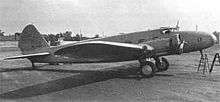

- Model 280
- Original proposal of Boeing 247 with 14 seats and 700 hp P&W Hornet engines.
- Model 247
- Twin-engined civil transport airliner. Initial production version
- 247A
- Powered by new 625 hp P&W Wasp, on special order for Deutsche Luft Hansa in 1934.
- 247E
- This designation was given to the first Boeing 247 aircraft, it was used to test a number improvements, that were later incorporated into the Boeing 247D
- 247D
- Original one-off was a race aircraft designed for the MacRobertson Air Race; use of Hamilton Standard variable-pitch propellers allowed for a 7 mph (11 km/h) gain; the 247D configuration incorporated in production series bearing the same name.
- 247Y
- Armed version, one exported to China, second used for trials.
- C-73
- Designation for Boeing 247D airliners "drafted" into military service in USAAF, 27 in total.
Operators
Civil operators

- Viação Aérea Bahiana operated one aircraft.
- Canadian Pacific Airlines
- Quebec Airways
- Private owner operated one aircraft.
- Boeing Air Transport (later United Air Lines) operated 60 aircraft.
- Empire Air Lines
- National Parks Airways
- Pennsylvania Central Airlines
- United Aircraft Corporation operated 10 aircraft.
- Wien Air Alaska
- Western Airlines received some of ex-United Aircraft Corporation aircraft.
- Woodley Airways
- Wyoming Air Service
Military operators
Accidents and incidents
- October 10, 1933 – A United Air Lines 247, NC13304 (c/n 1685), was the victim of the first proven case of sabotage of a commercial airliner. The aircraft, en route from Cleveland to Chicago, was destroyed by a nitroglycerin-based explosive device over Chesterton, Indiana.[29]
- November 9, 1933 - A Pacific Air Transport 247, NC13345 (c/n 1727), crashed on takeoff after the pilot became disoriented in fog and low visibility; four of ten on board died.
- November 24, 1933 - A National Air Transport 247, NC13324 (c/n 1705), crashed near Wedron, Illinois, killing both pilots.
- February 23, 1934 - A Boeing Air Transport 247, NC13357 (c/n 1739), struck a mountain near Salt Lake City in a snowstorm, killing all eight on board.
- December 20, 1934 - United Air Lines Flight 6, a 247 (NC13328, c/n 1709), crashed near Western Springs, Illinois, due to carburetor icing; all four on board survived. The aircraft involved was repaired and converted to 247D standard in July 1935 and returned to service; the aircraft was pressed into USAAF service in 1942 and redesignated as C-73 with tail number 42-57210. The aircraft was damaged in a wind storm at Duncan Field, Texas on August 30, 1942 and was written off.
- March 24, 1935 - The sole 247 operated by Lufthansa (D-AGAR, c/n 1945) was damaged beyond economical repair in a collision with an Air France aircraft on the ground at Nuremberg and then scrapped[23]
- September 1, 1935 - A Western Air Express 247, NC13314 (c/n 1695), was being ferried from Burbank, California to Saugus, California when it struck high tension power lines after takeoff, killing all three on board.
- October 7, 1935 – United Airlines Flight 4, a 247D (c/n 1698), went down about 10 miles (16 km) west of Cheyenne, Wyoming due to pilot error. Three crew and nine passengers killed, there were no survivors.[30]
- October 30, 1935 - A United Air Lines Boeing 247D, NC13323 (c/n 1704), crashed during an instrument checkflight near Cheyenne, killing the four crew members aboard.[31]
- December 15, 1936 – Seven died when Western Air Express Flight 6, a 247D,[32] en route from Burbank, California, to Salt Lake City via Las Vegas, crashed just below Hardy Ridge on Lone Peak in Utah.[33] The major parts of the aircraft were hurled over the ridge and fell over 1,000 ft into a basin below.[32]
- December 27, 1936 - United Airlines Trip 34, a 247D (c/n 1737), crashed at the head of Rice Canyon, Los Angeles County, California, due to pilot error; all 12 on board died.
- January 12, 1937 – Western Air Express Flight 7, a 247D (c/n 1696) flight from Salt Lake City to Burbank, crashed into a mountain near Newhall, California, killing five. Among the dead was Martin Johnson of Martin and Osa Johnson fame (adventurers, authors, and documentary filmmakers).[34]
- August 13, 1937 - A 247 being operated by the Luftwaffe's proving ground at Rechlin (formerly D-AKIN of Lufthansa, c/n 1944) crashed at Hannover, Germany during a test flight,[23] killing seven of eight on board. The aircraft was being used as a testbed for an experimental autopilot.
Surviving aircraft
- c/n 1699, CF-JRQ
- Exhibited in Canada Aviation and Space Museum, Ottawa. Donated to the museum in 1967 by California Standard Oil of Calgary, Alberta.[35]
- c/n 1722, N18E
- Exhibited in the National Museum of Science and Industry, Wroughton, UK
- c/n 1729, N13347
- Still airworthy, flown after restoration at the Museum of Flight Restoration Center, Paine Field, Snohomish County, Washington, USA to the Museum of Flight main facility on 26 April 2016 where it will be installed in that museum's Air Park .[36]
- c/n 1953, NC13369 / NR257Y
- Exhibited in the Hall of Air Transportation at the National Air and Space Museum, Washington, D.C., USA, with United Air Lines colors and registration as NC13369 on its right fuselage and wing and as NR257Y with MacRobertson Air Race markings on its left side.[18]
Specifications (Boeing 247D)
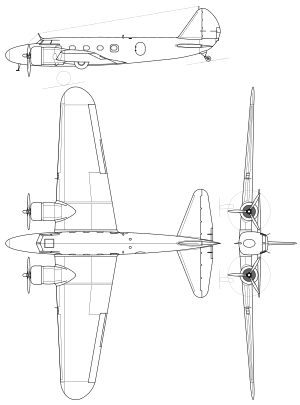
Data from The Concise Guide to American Aircraft of World War II [37]
General characteristics
- Crew: three [2]
- Capacity: ten passengers [2]
- Length: 51 ft 5 in (15.7 m)
- Wingspan: 74 ft 1 in (22.6 m)
- Height: 12 ft 5 in (3.8 m)
- Wing area: 836.4 ft² (78 m²)
- Empty weight: 8,921 lb (4,055 kg)
- Max. takeoff weight: 13,650 lb [2] (6,190 kg)
- Powerplant: 2 × Pratt & Whitney S1H1-G Wasp radial engine, 550 hp (410 kW) each
Performance
- Maximum speed: 200 mph (320 km/h)
- Cruise speed: 188 mph (304 km/h)
- Range: 745 miles (1,200 km)
- Service ceiling: 25,400 ft (7,620 m)
- Rate of climb: 1,148 ft/min (350 m/min)
In popular culture
A 1935 mystery novel, Obelists Fly High by C. Daly King, features a detailed description of a transcontinental flight on a Boeing 247, including an interior floor plan and passenger operations.
The 1936 movie Without Orders centers on the emergency landing of a Boeing 247 by the stewardess.
The 1936 movie 13 Hours by Air takes place largely aboard a transcontinental Boeing 247 flight and includes much historically interesting second-unit footage of actual terminal facilities on United Airline's then-new transcontinental route network.
Several episodes of The Untouchables (1959 TV series) feature insert shots of a Boeing 247.
See also
- Related development
- Aircraft of comparable role, configuration and era
- Related lists
References
- Notes
- 1 2 Bryan 1979, p. 109.
- 1 2 3 4 "Model 247 Commercial Transport." Archived January 18, 2008, at the Wayback Machine. boeing.com, 2009. Retrieved: June 14, 2010.
- ↑ van der Linden 1991, pp. xi–xii.
- ↑ Bryan 1979, p. 110.
- 1 2 3 4 5 Gould 1995, p. 14.
- ↑ Serling 1992, p. 19.
- ↑ Seely 1968, p. 58.
- 1 2 Seely 1968, p. 56.
- ↑ Serling 1992, p. 20.
- 1 2 3 4 Fernandez 1983, pp. 74–78, 104–105.
- ↑ "247D Type Certificate" (PDF). Federal Aviation Administration. FAA. Retrieved 5 May 2016.
- ↑ Serling 1992, p. 22.
- ↑ Pearcy 1995
- ↑ van der Linden 1991, p. 93.
- ↑ Holcomb, Kevin. "The Boeing 247." Airminded.net webpage showing initial and final windshield angles and glarescreen installation in the 247D, 2009. Retrieved: July 26, 2009.
- ↑ van der Linden 1991, p. 1.
- ↑ "Boeing Model 247: First modern airliner." acepilots.com, 2007. Retrieved: July 26, 2009.
- 1 2 3 4 "NASM Boeing 247D." Archived November 24, 2007, at the Wayback Machine. Wayback archive of NASM Boeing 247D, originally revised May 5, 2001. Retrieved: July 26, 2009.
- 1 2 Boeing Company 1969, p. 35.
- 1 2 3 4 "Boeing Model 247- USA." The Aviation History On-Line Museum, November 19, 2004. Retrieved: July 26, 2009.
- ↑ Serling 1992, p. 21.
- 1 2 'Das Große Buch der Lufthansa' Günter Stauch(Hrsg.) GeraMond Verlag 2003 ISBN 3-7654-7174-7 pp. 70–73
- 1 2 3 4 'Der Deutsche Luftverkehr 1926-1945' Karl-Dieter Seifert Bernard & Graefe Verlag, Bonn 1999 ISBN 3-7637-6118-7 pp.330-331
- ↑ Serling 1992, p. 23.
- ↑ "Boeing 247D." rcaf.com, 2009. Retrieved: July 26, 2009.
- ↑ Seely 1968, p. 63.
- ↑ Seely 1968, p. 69.
- ↑ Yenne 1989, pp. 54–59.
- ↑ "Seven die as plane crashes in flames". The New York Times, October 11, 1933, p. 1.
- ↑ van der Linden 1971, p. 174.
- ↑ "Cheyenne, WY United Airlines Plane Crashes." Associated Press for Centralia Daily Chronicle (Washington), October 31, 1935. Retrieved: December 5, 2011.
- 1 2 "Aircraft Accident Report, December 15, 1936 crash." Department of Commerce. Retrieved: November 8, 2009.
- ↑ "Confetti on Lone Peak." Time, June 21, 1937. Retrieved: November 8, 2009.
- ↑ Stokes, Keith. "Martin and Osa Johnson Safari Museum." kansastravel.org, 2009. Retrieved: July 26, 2009.
- ↑ "Boeing 247D." Canada Aviation and Space Museum Collection, 2009. Retrieved: July 26, 2009.
- ↑ http://www.warbirdsnews.com/uncategorized/flight-rare-1933-boeing-247d-airliner.html
- ↑ Mondey 1996, p. 34.
- Bibliography
- Bowers, Peter M. Boeing aircraft since 1916. London: Putnam Aeronautical Books, 1989. ISBN 0-85177-804-6.
- Bryan, C.D.B. The National Air and Space Museum. New York: Harry N. Abrams, Inc., 1979. ISBN 0-8109-0666-X.
- Fernandez, Ronald. Excess Profits: The Rise of United Technologies. Boston, Massachusetts: Addison-Wesley, 1983. ISBN 978-0-201-10484-4.
- Gould, William. Boeing (Business in Action). Bath, Avon, UK: Cherrytree Books, 1995. ISBN 0-7451-5178-7.
- Mondey, David, The Concise Guide to American Aircraft of World War II. London: Chancellor, 1996. ISBN 1-85152-706-0.
- Pearcy, Arthur. Douglas Propliners: DC-1–DC-7. Shrewsbury, UK: Airlife Publishing, 1995. ISBN 1-85310-261-X.
- Pedigree of Champions: Boeing Since 1916, Third Edition. Seattle, Washington: The Boeing Company, 1969. No ISBN. WorldCat.
- Seely, Victor. "Boeing's Grand Old Lady." Air Classics, Vol. 4, No. 6, August 1968.
- Serling, Robert J. Legend & Legacy: The Story of Boeing and its People. New York: St. Martin's Press, 1992. ISBN 0-312-05890-X.
- van der Linden, F. Robert. The Boeing 247: The First Modern Airliner. Seattle, Washington: University of Washington Press, 1991. ISBN 0-295-97094-4. Retrieved: July 26, 2009.
- Yenne, Bill. Boeing: Planemaker to the World. New York:, Crescent Books, 1989. ISBN 0-517-69244-9.
External links
| Wikimedia Commons has media related to Boeing 247. |
- Film of United Airlines Boeing 247 NC13364 taking off from Vancouver Airport 1934
- Gallery: Boeing 247 Images, including two of the interior and one of the retracted main gear
- Boeing Model 247: First modern airliner
- "From Mock Up To Latest Airliner," Popular Mechanics, October 1932, early article on future Model 247
- "Keeping Them In The Air" Popular Mechanics, July 1935 photos and colored artwork of 247 pp.9–16